Meiosis | Ploidy | Life Cycles | Phases of Meiosis | Prophase I | Metaphase I
Anaphase I | Telophase I | Prophase II | Metaphase II | Anaphase II | Telophase II
Comparison of Mitosis and Meiosis | Gametogenesis | Links
Sexual reproduction occurs only in eukaryotes. During the formation of gametes, the number of chromosomes is reduced by half, and returned to the full amount when the two gametes fuse during fertilization.
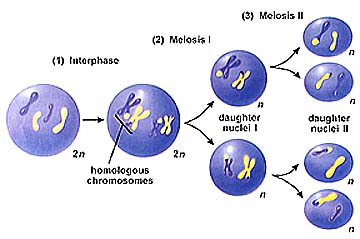
The above image is from http://www.biosci.uga.edu/almanac/bio_103/notes/apr_3.html.
Haploid and diploid are terms referring to the number of sets of chromosomes in a cell. Gregor Mendel determined his peas had two sets of alleles, one from each parent. Diploid organisms are those with two (di) sets. Human beings (except for their gametes), most animals and many plants are diploid. We abbreviate diploid as 2n. Ploidy is a term referring to the number of sets of chromosomes. Haploid organisms/cells have only one set of chromosomes, abbreviated as n. Organisms with more than two sets of chromosomes are termed polyploid. Chromosomes that carry the same genes are termed homologous chromosomes. The alleles on homologous chromosomes may differ, as in the case of heterozygous individuals. Organisms (normally) receive one set of homologous chromosomes from each parent.
Meiosis is a special type of nuclear division which segregates one copy of each homologous chromosome into each new "gamete". Mitosis maintains the cell's original ploidy level (for example, one diploid 2n cell producing two diploid 2n cells; one haploid n cell producing two haploid n cells; etc.). Meiosis, on the other hand, reduces the number of sets of chromosomes by half, so that when gametic recombination (fertilization) occurs the ploidy of the parents will be reestablished.
Most cells in the human body are produced by mitosis. These are the somatic (or vegetative) line cells. Cells that become gametes are referred to as germ line cells. The vast majority of cell divisions in the human body are mitotic, with meiosis being restricted to the gonads.
Life cycles are a diagrammatic representation of the events in the organism's development and reproduction. When interpreting life cycles, pay close attention to the ploidy level of particular parts of the cycle and where in the life cycle meiosis occurs. For example, animal life cycles have a dominant diploid phase, with the gametic (haploid) phase being a relative few cells. Most of the cells in your body are diploid, germ line diploid cells will undergo meiosis to produce gametes, with fertilization closely following meiosis.
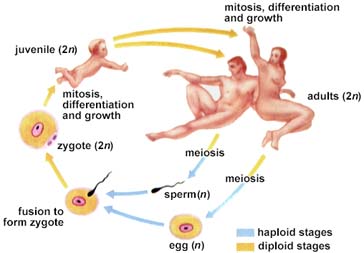
The above image is from http://www.biosci.uga.edu/almanac/bio_103/notes/apr_4.html.
Plant life cycles have two sequential phases that are termed alternation of generations. The sporophyte phase is "diploid", and is that part of the life cycle in which meiosis occurs. However, many plant species are thought to arise by polyploidy, and the use of "diploid" in the last sentence was meant to indicate that the greater number of chromosome sets occur in this phase. The gametophyte phase is "haploid", and is the part of the life cycle in which gametes are produced (by mitosis of haploid cells). In flowering plants (angiosperms) the multicelled visible plant (leaf, stem, etc.) is sporophyte, while pollen and ovaries contain the male and female gametophytes, respectively. Plant life cycles differ from animal ones by adding a phase (the haploid gametophyte) after meiosis and before the production of gametes.
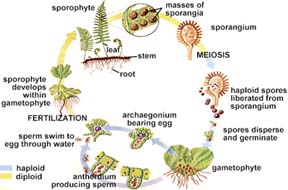
The above is from http://www.biosci.uga.edu/almanac/bio_104/notes/apr_3.html.
Many protists and fungi have a haploid dominated life cycle. The dominant phase is haploid, while the diploid phase is only a few cells (often only the single celled zygote, as in Chlamydomonas ). Many protists reproduce by mitosis until their environment deteriorates, then they undergo sexual reproduction to produce a resting zygotic cyst.
Two successive nuclear divisions occur, Meiosis I (Reduction) and Meiosis II (Division). Meiosis produces 4 haploid cells. Mitosis produces 2 diploid cells. The old name for meiosis was reduction/ division. Meiosis I reduces the ploidy level from 2n to n (reduction) while Meiosis II divides the remaining set of chromosomes in a mitosis-like process (division). Most of the differences between the processes occur during Meiosis I.
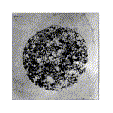
The above image is from http://www.biology.uc.edu/vgenetic/meiosis/
Prophase I has a unique event -- the pairing (by an as yet undiscovered mechanism) of homologous chromosomes. Synapsis is the process of linking of the replicated homologous chromosomes. The resulting chromosome is termed a tetrad, being composed of two chromatids from each chromosome, forming a thick (4-strand) structure. Crossing-over may occur at this point. During crossing-over chromatids break and may be reattached to a different homologous chromosome.
The alleles on this tetrad:
A B C D E F G
A B C D E F G
a b c d e f g
a b c d e f g
will produce the following chromosomes if there is a crossing-over event between the 2nd and 3rd chromosomes from the top:
A B C D E F G
A B c d e f g
a b C D E F G
a b c d e f g
Thus, instead of producing only two types of chromosome (all capital or all lower case), four different chromosomes are produced. This doubles the variability of gamete genotypes. The occurrence of a crossing-over is indicated by a special structure, a chiasma (plural chiasmata) since the recombined inner alleles will align more with others of the same type (e.g. a with a, B with B). Near the end of Prophase I, the homologous chromosomes begin to separate slightly, although they remain attached at chiasmata.

Image from W.H. Freeman and Sinauer Associates, used by permission.
Events of Prophase I (save for synapsis and crossing over) are similar to those in Prophase of mitosis: chromatin condenses into chromosomes, the nucleolus dissolves, nuclear membrane is disassembled, and the spindle apparatus forms.
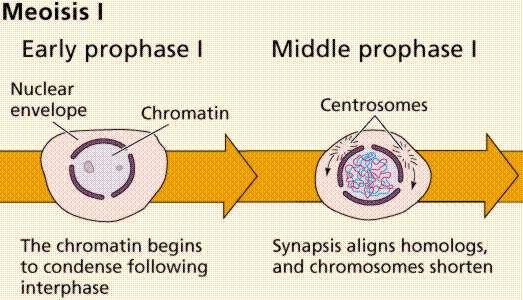
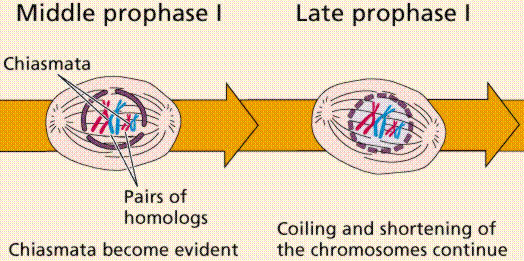
Image from W.H. Freeman and Sinauer Associates, used by permission.
Metaphase I is when tetrads line-up along the equator of the spindle. Spindle fibers attach to the centromere region of each homologous chromosome pair. Other metaphase events as in mitosis.
Anaphase I is when the tetrads separate, and are drawn to opposite poles by the spindle fibers. The centromeres in Anaphase I remain intact.
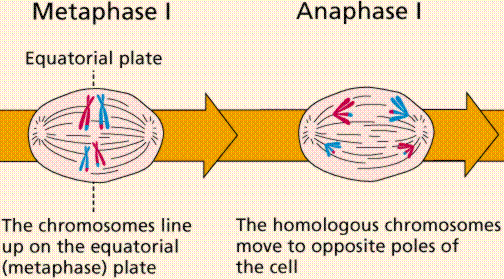
Image from W.H. Freeman and Sinauer Associates, used by permission.
Telophase I is similar to Telophase of mitosis, except that only one set of (replicated) chromosomes is in each "cell". Depending on species, new nuclear envelopes may or may not form. Some animal cells may have division of the centrioles during this phase.
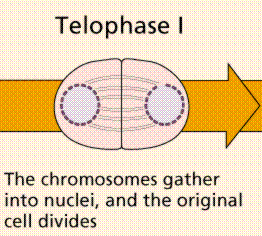
Image from W.H. Freeman and Sinauer Associates, used by permission.
During Prophase II, nuclear envelopes (if they formed during Telophase I) dissolve, and spindle fibers reform. All else is as in Prophase of mitosis. Indeed Meiosis II is very similar to mitosis.
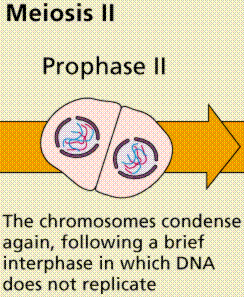
Image from W.H. Freeman and Sinauer Associates, used by permission.
Metaphase II is similar to mitosis, with spindles moving chromosomes into equatorial area and attaching to the opposite sides of the centromeres in the kinetochore region.
During Anaphase II, the centromeres split and the former chromatids (now chromosomes) are segregated into opposite sides of the cell.
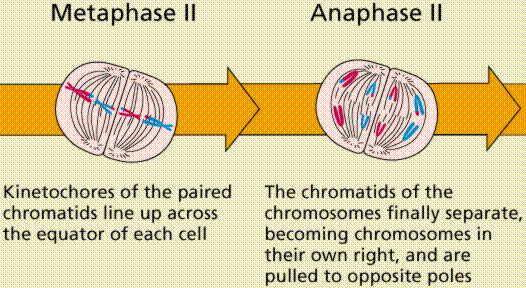
Image from W.H. Freeman and Sinauer Associates, used by permission.
Telophase II is identical to Telophase of mitosis. Cytokinesis separates the cells.
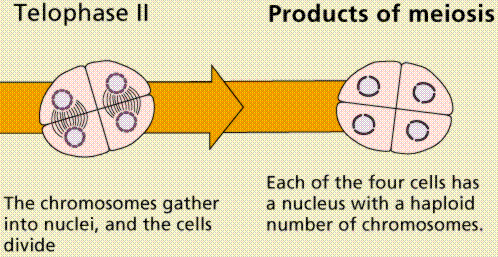
Image from W.H. Freeman and Sinauer Associates, used by permission.
Mitosis maintains ploidy level, while meiosis reduces it. Meiosis may be considered a reduction phase followed by a slightly altered mitosis. Meiosis occurs in a relative few cells of a multicellular organism, while mitosis is more common.
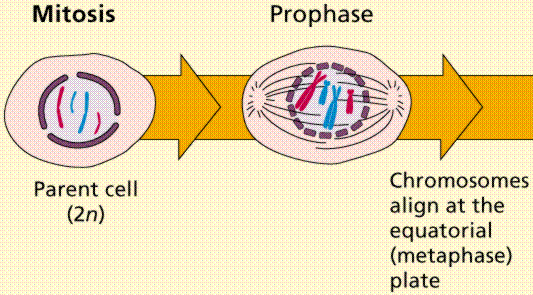
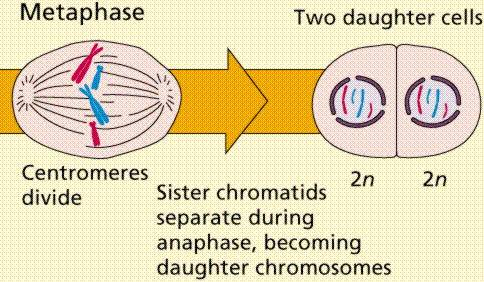
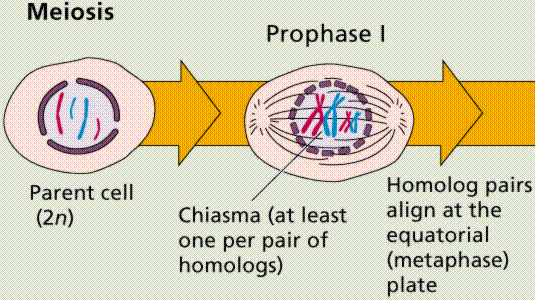
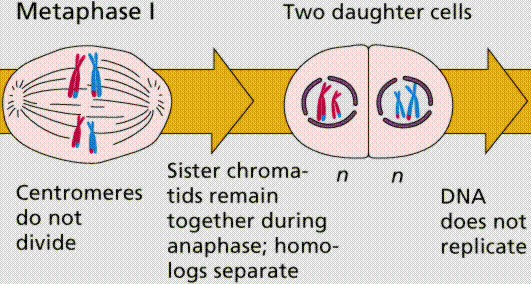
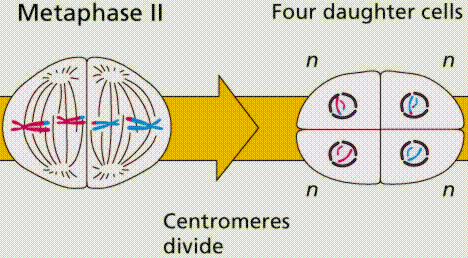
Images from W.H. Freeman and Sinauer Associates, used by permission.
Gametogenesis is the process of forming gametes (by definition haploid, n) from diploid cells of the germ line. Spermatogenesis is the process of forming sperm cells by meiosis (in animals, by mitosis in plants) in specialized organs known as gonads (in males these are termed testes). After division the cells undergo differentiation to become sperm cells. Oogenesis is the process of forming an ovum (egg) by meiosis (in animals, by mitosis in the gametophyte in plants) in specialized gonads known as ovaries. Whereas in spermatogenesis all 4 meiotic products develop into gametes, oogenesis places most of the cytoplasm into the large egg. The other cells, the polar bodies, do not develop. This all the cytoplasm and organelles go into the egg. Human males produce 200,000,000 sperm per day, while the female produces one egg (usually) each menstrual cycle.
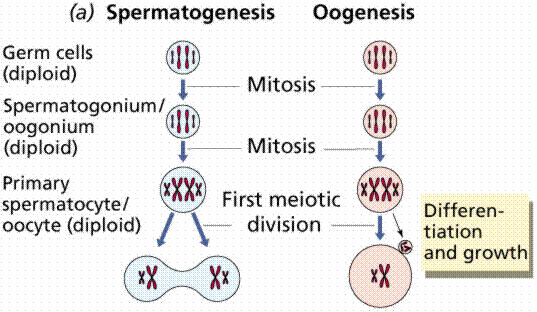
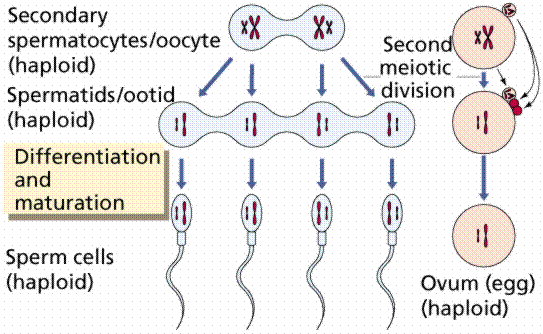
Images from W.H. Freeman and Sinauer Associates, used by permission.
Back to Table of Contents | Mitosis Page
Email: mj.farabee@emcmail.maricopa.edu![]()
Last modified: 2000/01/08:22:23:15
The URL of this page is: gened.emc.maricopa.edu/bio/BIO181/BIOBK/BioBookmeiosis.html